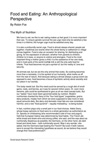Food and Eating: An Anthropological Perspective
– By Robin Fox
You Eat What You Are
Since everyone must eat, what we eat becomes a most powerful symbol of who we are. To set yourself apart from others by what you will and will not eat is a social barrier almost as powerful as the incest taboo, which tells us with whom we may or may not have sex. Some cultures equate the two taboos. Margaret Mead quotes a New Guinea proverb that goes, "Your own mother, your own sister, your own pigs, your own yams which you have piled up, you may not eat." Own food, like related women, is for exchange, for gift giving, for social generosity, for forging alliances, but not for personal consumption. The obverse of this is that you identify yourself with others by eating the same things in the same way. To achieve such identification, people will struggle to eat things they loath, and avoid perfectly tasty food that is on the forbidden list. In the process of social climbing people have to learn to like caviar, artichokes, snails, and asparagus, and scorn dumplings, fish and chips, and meat and potato pie - all more nutritious, but fatally tainted with lower-class associations.
There are as many kinds of food identification as there are the same in fashion, speech, music, manners and the like. The obvious ones are ethnic, religious and class identifications. Ethnic food preferences only become identity markers in the presence of gustatory "foreigners," such as when one goes abroad, or when the foreigners visit the home shores. The insecure will cling desperately to home food habits: English housewives on the continent even break open tea bags to make a "proper" cup of tea (the taste is identical). Popular songs attest to the food difficulties of interethnic marriages’ "bangers and mash vs. macaroni." When various ethnic groups are forcibly thrown together, there is both an intensifying of food identity and a growing mishmash. The American melting pot is almost literally that: the food preferences of dozens of nations are put side by side, and there cannot help but be overlap and mixing. The most startling example is the popularity of the Chinese kosher restaurant, and it is not uncommon to find a restaurant advertising itself as "Chinese-Italian-American" along with the proud boast "All Our Wines Are Chilled." The ubiquitous "diner" with its vast menu served twenty-four hours a day is a microcosm of the melting pot, having Greek salad, Italian pasta, German rye bread, Polish kielbasi, Chinese chow mein, Belgian waffles, French quiche, Hungarian goulash, Irish stew, Jewish gefilte fish, Russian blintzes, English muffins, Austrian pastries, Swiss cheese, Mexican enchiladas, Spanish gazpacho, Canadian bacon, Japanese teriyaki, German sausages, Norwegian herring, Lebanese pita, Nova Scotia salmon and Virginia ham.


